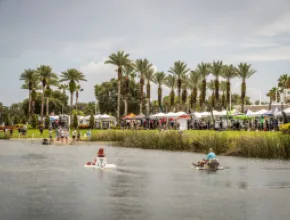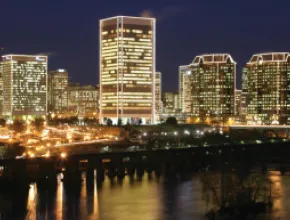With its patchwork of mountains, parks, rivers and lakes, Portland reigns as an adventure-seeker’s paradise. From the foothills of Mt. Hood to the banks of the Willamette River, kayaking, hiking and biking all play into the equation. Yet Portland also flaunts a sophisticated flare with its very own cultural district, upscale restaurants and proximity to Willamette County’s Pinot-producing wineries.
"That’s always been our sweet spot, our natural attractions," says Mike Smith, vice president of convention sales for Travel Portland. "You can be on the top of Mt. Hood in snow in the middle of July in 45 minutes, wine country in a half-hour or the coast in an hour and 15 minutes. You can’t do that any place else."
While its tourist-friendly attributes are often heralded, Portland knows how to get down to business. The city is the first in the country to launch an official "Twisitor Center," a cyber version of a visitor information center that relies on Twitter technology to connect travelers with those who can answer their questions and help plan their trips.
In addition to its tech savvy offerings, Portland caters to groups with nearly 1 million square feet at the Oregon Convention Center (OCC), the largest convention facility in the Pacific Northwest. Currently, the facility offers 255,000 square feet of contiguous exhibit space, 50 meeting rooms and two grand ballrooms.
In keeping with the city’s emphasis on sustainability, the OCC last year was recertified with the LEED Silver rating from the United States Green Building Council, making it the first convention center in the nation to achieve recertification at a higher rating. The facility is easily accessed by Portland’s public transit, namely on TriMet’s MAX light rail line with its own designated station within the city’s downtown ride-for-free transit zone.
"We’ve always sold ourselves as a really cool city that is affordable and that is green," Smith says. "The green aspect is becoming a more powerful statement across the country and really starting to matter. We lead the pack in that respect."
The rail line is expanding as well. The MAX Green Line debuted in September and carries riders from Clackamas Town Center to Portland City Center in less than 40 minutes. Each station along the extension showcases a sculpture, thanks to TriMet, which allocated $495,000 for the public art program. In addition, over the last two years, the Portland Mall, or transit mall, has been undergoing major renovations, including new artwork installations by local and regional artists.
Federal money will also be used to take the rail line farther east, with construction slated for later this year or next year, according to Smith. A new Portland Streetcar Loop is also in the works, which would connect Lloyd Center to the Oregon Museum of Science and Industry (OMSI) and also connect to the existing downtown streetcar system.
Travel Portland, with assistance from MeetGreen, formerly Meeting Strategies Worldwide, launched an online Green Meetings Toolkit designed to assist meeting planners interested in creating more sustainable events. The website contains tips, resources, interactive maps and links to experts. All of the suggested businesses and tours are highlighted on interactive maps that link to GoSeePortland.com, a social-networking website on which planners will find ratings and reviews posted by various travelers to Portland.
In this economy, the city’s affordability is also key.
"The fact that you don’t have a sales tax, food tax or beverage tax speaks loudly to planners. And there is no shopping tax," Smith says. "Something we always remind planners, if you are having catered functions, there is not a sales tax. That takes off 15 to 18 percent of what it would cost in any other city."
What is missing for now is a convention center headquarter hotel, a project still in the works.
"We’re making progress, but it’s slow," Smith says. "Our challenge is we’ve got some of the best hotels in the country, but they’re not big. The largest in Oregon is the Hilton, but that is only 700 rooms. We do have boutique properties to die for."
The city is home to nearly 24,000 hotel rooms, including the Gold LEED certified Courtyard by Marriott-Portland City Center, which opened with 256 rooms in June. The hotel offers more than 5,000 square feet of meeting space.
Other options include the Hilton Portland & Executive Tower, the Portland Marriott Downtown Waterfront, Doubletree Hotel & Executive Meeting Center Portland–Lloyd Center, Sheraton Hotel Portland Airport and Holiday Inn Portland–Downtown Convention Center, as well as boutique properties like the Ace Hotel. Meanwhile, Portland’s Governor Hotel is celebrating its centennial birthday this year.
McMenamins Hotels, Pubs & Breweries, a Portland-based company that focuses on renovating and repurposing historic buildings, is transforming a 1911 structure in downtown Portland into a full-service property to be named the Crystal Hotel, scheduled to open in early 2010. The 50-room hotel will connect to the company’s existing Ringlers Annex Pub next door. The new property will be one block from McMenamins Crystal Ballroom, a historic venue that has presented live national music and dance acts since the 1920s.
About a half-hour from downtown Portland, Oregon Wine Country’s Allison Inn & Spa opened in September with 85 guest rooms and 12,000 square feet of meeting space.
Just as extensive as its hotel options, Portland offers the gamut of outdoor and indoor adventures, spread throughout its distinct neighborhoods.
Summertime venues include the Governor Tom McCall Waterfront Park on the banks of the Willamette River, where boats like the Portland Spirit can accommodate groups. The popular Portland Saturday Market recently relocated to this riverfront location from the Old Town district. The market is the nation’s largest continuously operating arts and craft market, and has been a Portland tradition since 1974. The relocation is part of a $10 million Waterfront Park improvement project that includes an 8,000-square-foot, open-sided pavilion, a deck overlooking the river and a circular plaza containing the new Bill Naito Legacy Fountain.
Another of Portland’s parks, downtown’s South Park Blocks, is dubbed the Cultural District, as it is bordered by the Arlene Schnitzer Concert Hall, Antoinette Hatfield Hall of the Portland Center for the Performing Arts, Portland Art Museum, Oregon Historical Society and the campus of Portland State University.
For multicultural flare, Northeast Alberta Street between 12th and 31st avenues features African-American galleries, underground arts studios, funky boutiques and a blend of culinary flavors at its many restaurants. Named the Alberta Arts District, the area hosts Last Thursday on Alberta, when galleries, studios and other art venues stay open late. Its counterpart is Old Town’s and the Pearl District’s First Thursday event, held on the first Thursday of each month.
"The Pearl District has been around a long time, but has caught on and is being redeveloped with a lot of condos," Smith says.
The Pearl District is home to the Gerding Theater, formerly an armory and now a popular off-site venue. The theater also caters meal functions.
"It has just a beautiful design on the outside—it looks like a small castle or fortress," Smith says.
Smith also notes the nightlife and culinary offerings in trendy Nob Hill as well as the antique shops that draw visitors to the Sellwood district.
Burgeoning areas include Southeast Hawthorne Boulevard and Southeast Belmont Street, with an eclectic range of nightlife and theaters. Anchoring the Hawthorne district is the historic Bagdad Theater and Pub, a restored Moorish-style building owned by the McMenamin brothers.
"The Hawthorne area is really coming online as a district of its own," Smith says.
Another trendy spot, the Hollywood District, draws visitors to its antique shops and 1926-era Hollywood Theatre. The northeast Portland neighborhood also is known for its tree-lined streets and old-style homes and restaurants. Another buzz-worthy neighborhood, East Burnside, or LoBu for Lower Burnside, lies across the river from Old Town and sports an array of bars and live music spots.
Aside from the Oregon Convention Center, the city’s other large group venue is the Portland Expo Center, offering 330,000 square feet of exhibition space and 11 meeting rooms.
Vancouver, Wash.
Many of Vancouver’s charms lie in its location. Set on the north bank of the Columbia River directly across from Portland, Vancouver offers easy access to big-city amenities as well as a full scope of outdoor adventure.
"Being on the Columbia River is gorgeous," says Rosemary Cooke, director of sales for the Southwest Washington CVB. "It’s one of those locations you have to see to believe."
Groups can experience everything from trendy restaurants and wineries to historic heritage.
Accessibility is also an attraction, whether flying, driving or taking the train. The city is right along the Interstate 5 corridor and also close to Portland International Airport. The destination works with Portland, located 15 minutes away, for overflow opportunities, but also stands as a destination on its own, one that is gaining popularity with groups.
"We’re seeing groups that are willing to give us an opportunity," Cooke says. "We are definitely focusing on the associations in the region and working on government groups. There is a lot of repeat business, and a lot of it is growing."
The area has no shortage of outdoor activities. Groups can arrange to try wakeboarding on the Columbia River at the Columbia River Gorge, known for its ideal windsurfing and kite boarding conditions. A new company, Western Wakes, is offering wakeboard adventures for any level. Jet boat rides can be also be arranged at the Columbia Gorge. Skamania Lodge is a favorite meetings retreat in the region.
Also close by, Mount St. Helens sits an hour-and-a-half north of the city, offering hiking and cross-country skiing, as well as helicopter tours that take in views of its erupted cone. Just a two-hour drive west of Vancouver lies the Pacific Ocean, offering everything from kayaking to kite flying, clamming to treasure hunting, and fishing to beach combing.
Urban options include art galleries, glass-blowing demonstrations or an evening at trendy Big Al’s bowling alley. There are also eight wineries in the region, some located in Battleground, Ridgefield and East County, all within a 20-minute drive. Many cater to groups, such as the East Fork Cellars Winery and Tasting Room in Ridgefield.
In Vancouver itself, groups can take tours of the Fort Vancouver National Site, home to Fort Vancouver, the Pearson Air Museum and Officers Row. Groups can use the Clark County Event Center, with 97,200 square feet of unobstructed show space.
Vancouver’s three largest meetings properties include the LEED-certified Hilton Vancouver Washington and Vancouver Convention Center, which provides 226 guest rooms and 30,000 square feet of meeting space; the Red Lion Hotel Vancouver at the Quay; and The Heathman Lodge, which recently underwent an expansion, adding over 4,200 square feet of meeting space in a new wing of the hotel for a total of nearly 10,000 square feet of flexible meeting space. In addition, the hotel added 40 new guest rooms and suites.
A 91-room Holiday Inn Express Hotel & Suites opened in March near the Westfield Vancouver Shopping Mall, while the Best Western Parkersville Inn & Suites in Washougal opened in April with 79 rooms.







